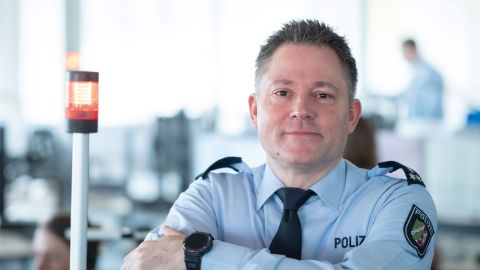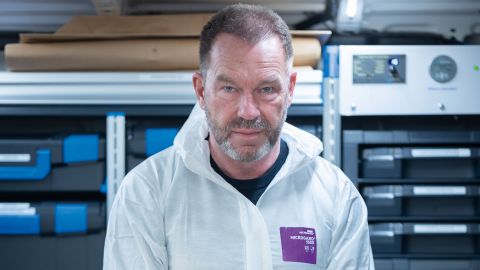If he had known that this bank branch had already been blown up twice, the homeless man would probably have chosen a different place to spend the night. Covered with the worn doormat of the vestibule, he had huddled into an alcove to sleep when three men detonated the explosives in the ATM at 3.09 am. The room afterwards - a field of rubble. It is a miracle that the homeless man remains unharmed.
Neheim-Hüsten, the Deutsche Bank branch on February 27 of this year. Images of destruction that the police have known for years. In 2022 alone, 182 ATMs were blown up and looted in North Rhine-Westphalia. The amounts looted run into five to six figures. The perpetrators mostly come from the Netherlands and commit their crimes in a highly professional, fast and efficient manner. Their escape is as ruthless as it is dangerous. Using the dense highway network in powerful cars, they disappear as quickly as they appear, heading home.
"Audi gang, that's what we called them when the first ATMs were robbed in 2015. Then it turned out that it wasn't just a banal series of crimes, but a phenomenon," says criminalist Christa Lübbers, head of Soko BEGAS (combating and investigating ATM blasts). When she took on this job two years ago, there were definitely warnings from colleagues: she couldn't win anything with this topic. It was a pretty hopeless fight against gang crime.
In the meantime, the number of blasts has dropped significantly: to eight in the first quarter of this year compared to 47 in the same period last year. The Soko BEGAS, a small team, has concentrated on analyzing the cases and restructuring the investigations.
The local police authorities are still the first on the scene with their men, securing the crime scene. But then the specialists arrive. These are officers from the 16 police headquarters with forensic investigation units, KTU investigators, explosives experts and structural engineers. Men and women who now know such crime scenes and the perpetrators' methods all too well. In addition to the State Criminal Police Office of North Rhine-Westphalia, the six major authorities in NRW are also involved: Bielefeld, Dortmund, Essen, Düsseldorf, Münster and Cologne. This is where the threads come together.
Cologne, on the fifth floor of the police headquarters. The authority's control center is located behind a wide strip of windows with a view of the LANXESS Arena and the Deutz district. Between 1,100 and 1,200 emergency calls are received here every day. At 13 workstations, each equipped with four monitors. "When an emergency call comes in, when we receive a report that an ATM has been blown up, we set up the entire apparatus in a very short time, communicating with all the agencies involved in the search measures," explains Ralf Bojack, one of six heads of the service group.
"The processes are now well established. Everyone involved is on the same page. It's like working through a checklist," says 53-year-old First Chief Superintendent Bojack.
A few floors below is where Frank Trojan works. The 59-year-old detective chief inspector knows the methods used by ATM burglars better than almost anyone else. Trojan is in charge of the KTU in Cologne and is one of the first people to arrive at a crime scene. He knows how important it is to act with extreme caution. Is the building still structurally sound or is it no longer safe due to the detonation? What about the rubble in front of the ATM, could there still be explosives underneath?"
"The crime scenes often look devastating. For some time now, the perpetrators have been using solid explosives instead of gas to detonate them. Recently, a monitor was blown 46 meters out during the explosion. It was lying on the sidewalk far away from the branch," reports Trojan.
Soko BEGAS intensified its contacts with the Dutch police and set up special working groups and a fixed system of contact persons. They also worked intensively with the banks, identified the most vulnerable of the approximately 11,000 ATMs in NRW and advised the institutions on how they can better protect themselves. This ranges from consistently locking individual branches at night to preparing the machines with robbery-stopping ink. This ensures that the banknotes are sprayed with ink when they explode, making them permanently recognizable as stolen goods.
Few crimes are captured on photos or videos as frequently as ATM explosions. There are almost always residents who are startled by the detonation at night and reach for their cell phones. "Recently, one resident even ran out of his house and stood in front of the perpetrators' car with his arms raised to prevent them from escaping. He was lucky that they only pushed him aside. Something like that is life-threatening!" says forensic expert Trojan.
Cologne investigator Christina B. (name changed) knows this all too well. Together with her colleagues from KK 63, she recently arrived at a crime scene that actually seemed to be safe. Just in time, she realized that there was a new type of explosives pack in the cash slot of a second vending machine that had not been detonated. "There's something else!" she warned and hurriedly called the experts from the LKA for help.
One of the biggest successes in the investigation into the ATM blast was achieved by the Romeo police, named after the car brand favored by the perpetrators. Following tips from the Federal Criminal Police Office, the team spent months tracking down a group of six Romanians who, hidden in a middle-class residential area in Niederkassel, were in some cases operating throughout Europe. Cologne investigator Bernd K. (39) proudly recounts how they put together the pieces of the puzzle of vehicle thefts, ATM blasts and burglaries until, after months of surveillance, a special task force was able to intervene. Individual members of the gang have now stood trial in Düsseldorf and received sentences of up to ten years in prison. However, the verdict is not yet final because it is being appealed.
Bernd K.: "Sometimes it's a lucky coincidence that leads to the decisive success. In this case, the perpetrators were caught in speed traps with their cars!" A case that caused a stir among criminologists throughout Europe. Bernd K. was even invited to the gendarmerie in Paris to report on the details of the manhunt.


